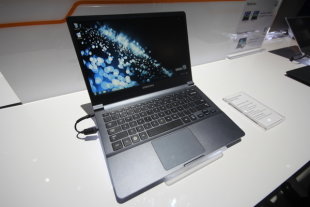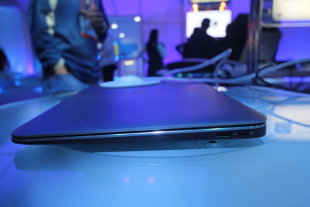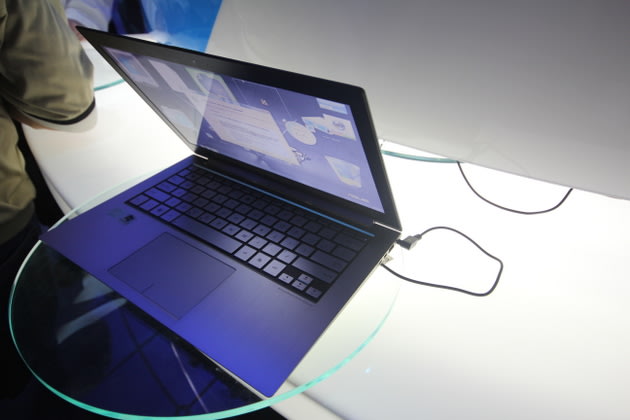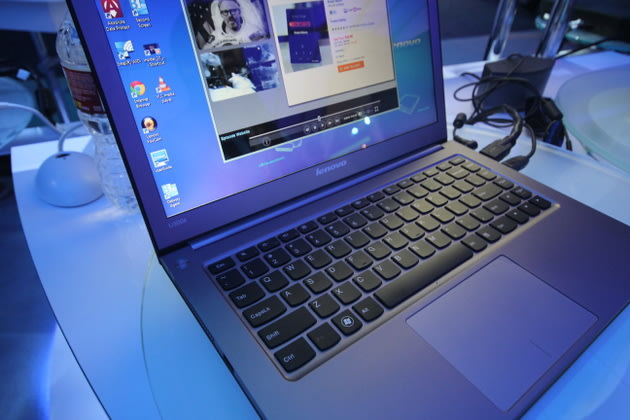House Speaker John Boehner of Ohio, second from right, accompanied by fellow Republican leaders, gestures during a news conference on Capitol Hill in Washington, Wednesday, Jan. 18, 2012, to voice their opposition to President Barack Obama's decision to reject the Keystone XL pipeline. From left are, Rep. Tim Griffin, R-Ark.; Rep. Jeb Hensarling, R-Texas; Boehner; and House Majority Leader Eric Cantor of Va. (AP Photo/J. Scott Applewhite)
House Speaker John Boehner of Ohio, second from right, accompanied by fellow Republican leaders, gestures during a news conference on Capitol Hill in Washington, Wednesday, Jan. 18, 2012, to voice their opposition to President Barack Obama's decision to reject the Keystone XL pipeline. From left are, Rep. Tim Griffin, R-Ark.; Rep. Jeb Hensarling, R-Texas; Boehner; and House Majority Leader Eric Cantor of Va. (AP Photo/J. Scott Applewhite)
House Speaker John Boehner of Ohio, center, accompanied by fellow Republican leaders, gestures during a news conference on Capitol Hill in Washington, Wednesday, Jan. 18, 2012, to voice their opposition to President Barack Obama's decision to reject the Keystone XL pipeline. From left are, House Energy and Commerce Committee Chairman Rep. Fred Upton, R-Mich.; Rep Tim Griffin, R-Ark.; Rep. Jeb Hensarling, R-Texas; Boehner; and House Majority Leader Eric Cantor of Va. (AP Photo/J. Scott Applewhite)
Rep. Tim Griffin, R-Ark., second from left, accompanied by fellow Republican leaders, gestures during a news conference on Capitol Hill in Washington, Wednesday, Jan. 18, 2012, to object to President Barack Obama's decision to reject the Keystone XL pipeline. From left are: Energy and Commerce Committee Chairman Rep. Fred Upton, R-Mich.; Griffin; Rep. Jeb Hensarling, R-Texas, and House Speaker John Boehner of Ohio. (AP Photo/J. Scott Applewhite)
House Speaker John Boehner of Ohio, center, accompanied by House Majority Leader Eric Cantor of Va., right, and Rep. Jeb Hensarling, R-Texas, gestures during a news conference on Capitol Hill in Washington, Wednesday, Jan. 18, 2012, to discuss President Barack Obama's decision to halt the Keystone XL pipeline. (AP Photo/J. Scott Applewhite)
WASHINGTON (AP) ? In a politically explosive decision, President Barack Obama on Wednesday rejected plans for a massive oil pipeline through the heart of the United States, ruling there was not enough time for a fair review before a looming deadline forced on him by Republicans. His move did not kill the project but could again delay a tough choice for him until after the November elections.
Right away, the implications rippled across the political spectrum, stirred up the presidential campaign and even hardened feelings with Canada, a trusted U.S. ally and neighbor. For a U.S. electorate eager for work, the pipeline has become the very symbol of job creation for Republicans, but Obama says the environment and public safety must still be weighed too.
The plan by Calgary-based TransCanada Corp. would carry tar sands oil from western Canada across a 1,700-mile pipeline across six U.S. states to Texas refineries.
Obama was already on record as saying no, for now, until his government could review an alternative route that avoided environmentally sensitive areas of Nebraska ? a route that still has not been proposed, as the White House emphasizes. But Obama had to take a stand again by Feb. 21 at the latest as part of an unrelated tax deal he cut with Republicans.
This time, the project would go forward unless Obama himself declared it was not in the national interest. The president did just that, reviving intense reaction.
"This announcement is not a judgment on the merits of the pipeline, but the arbitrary nature of a deadline that prevented the State Department from gathering the information necessary to approve the project and protect the American people," Obama said in a written statement. "I'm disappointed that Republicans in Congress forced this decision."
Republicans responded unsparingly.
"President Obama is destroying tens of thousands of American jobs and shipping American energy security to the Chinese. There's really just no other way to put it. The president is selling out American jobs for politics," House Speaker John Boehner, R-Ohio, said. Insisting that the pipeline would help the economy, he declared: "This is not the end of the fight," signaling that Republicans might try again to force a decision.
The State Department said the decision was made "without prejudice," meaning TransCanada can submit a new application once a new route is established. Russ Girling, TransCanada's president and chief executive officer, said the company plans to do exactly that. If approved, the pipeline could begin operation as soon as 2014, Girling said.
It did not take long for the Republicans seeking Obama's job to slam him.
Newt Gingrich, campaigning for the GOP presidential nomination in South Carolina, called Obama's decision "stunningly stupid," adding: "What Obama has done is kill jobs, weaken American security and drive Canada into the arms of China out of just sheer stupidity."
Republican presidential front-runner Mitt Romney said the decision was "as shocking as it is revealing. It shows a president who once again has put politics ahead of sound policy."
Project supporters say U.S. rejection of the pipeline would not stop it from being built. Canadian Prime Minister Stephen Harper has said Canada is serious about building a pipeline to its West Coast, where oil could be shipped to China and other Asian markets.
Harper on Wednesday told Obama he was profoundly disappointed that Obama turned down the pipeline, Harper's office said.
Alex Pourbaix, TransCanada's president for energy and oil pipelines, said last week the company soon will have a new route through Nebraska "that everyone agrees on."
The proposed $7 billion pipeline would run through Montana, South Dakota, Nebraska, Kansas and Oklahoma en route to Texas.
The pipeline is a dicey proposition for Obama, who enjoyed strong support from both organized labor and environmentalists in his winning 2008 campaign for the White House.
Environmental advocates have made it clear that approval of the pipeline would dampen their enthusiasm for Obama in the upcoming November election. Some liberal donors even threatened to cut off funds to Obama's re-election campaign to protest the project, which opponents say would transport "dirty oil" that requires huge amounts of energy to extract.
But by rejecting the pipeline, Obama risks losing support from organized labor, a key part of the Democratic base, for thwarting thousands of jobs.
"The score is Job-Killers, two; American workers, zero," said Terry O'Sullivan, general president of the Laborers' International Union of North America.
O'Sullivan called the decision "politics at its worst" and said, "Blue collar construction workers across the U.S. will not forget this."
Yet some unions that back Obama oppose the pipeline, included United Auto Workers, Service Employees International Union and Communications Workers of America.
TransCanada says the pipeline could create as many as 20,000 jobs, a figure opponents say is inflated. A State Department report last summer said the pipeline would create up to 6,000 jobs during construction.
Obama appeared to have skirted what some dubbed the "Keystone conundrum" in November when the State Department announced it was postponing a decision on the pipeline until after this year's election. Officials said they needed extra time to study routes that avoid an environmentally sensitive area of Nebraska that supplies water to eight states.
The affected area stretches just 65 miles through the Sandhills region of northern Nebraska, but the concerns were serious enough that the state's governor and senators opposed the project until the pipeline was moved. The new route, which has not been chosen, would have to be approved by Nebraska environmental officials and the State Department, which has authority because the pipeline would cross an international border.
Obama said his decision does not "change my administration's commitment to American-made energy that creates jobs and reduces our dependence on oil."
To underscore the point, Obama signaled that he would not oppose development of an oil pipeline from Oklahoma to refineries along the Gulf of Mexico. TransCanada already operates a pipeline from Canada to Cushing, Okla.
Refineries in Houston and along the Texas Gulf Coast can handle heavy crude such as that extracted from Canadian tar sands ? the type of oil that would flow through the Keystone XL pipeline.
Sen. Kent Conrad, D-N.D., said he doesn't believe the Keystone XL is a dead project. He said the Obama administration did not have enough time to review the project, given the Republican-imposed timeline.
"I don't believe this is the end of the story," Conrad told The Associated Press. "My personal view is that it should be constructed. It's clear Canada is going to develop this resource, and I believe it is better for our country to have it go here rather than Asian markets."
Bill McKibben, an environmental activist who led opposition to the pipeline, praised Obama's decision to stand up to what he called a "naked political threat from Big Oil." Jack Gerard, the oil industry's top lobbyist, had said last week that Obama faced "huge political consequences" if he rejected the pipeline.
"It's not only the right thing, it's a very brave thing to do," McKibben said. "That's the Barack Obama I think people thought they were electing back in 2008."
___
Associated Press writers Dina Cappiello, Laurie Kellman and Sam Hananel in Washington, Shannon McCaffrey in Warrenville, S.C., Ramit Plushnick-Masti in Houston and James MacPherson in Bismarck, N.D., contributed to this report.
___
Follow Matthew Daly on Twitter: (at)MatthewDalyWDC.
Follow Ben Feller on Twitter: (at)BenFellerDC
Associated Presstexas judge tom brokaw maria shriver andy irons ethan zohn jeremy mayfield occupy oakland general strike











